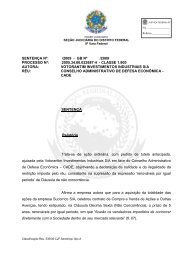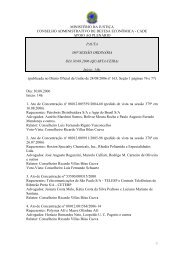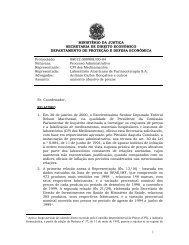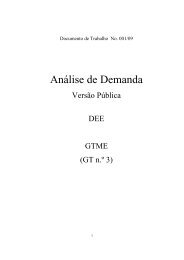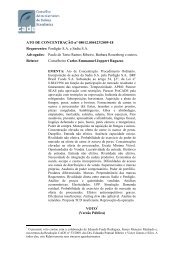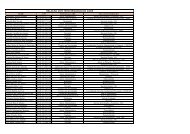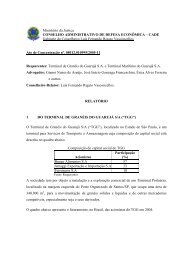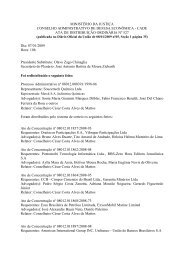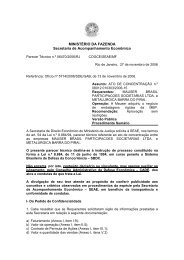Suggested Outline for Sao Paulo Presentation
Suggested Outline for Sao Paulo Presentation
Suggested Outline for Sao Paulo Presentation
Create successful ePaper yourself
Turn your PDF publications into a flip-book with our unique Google optimized e-Paper software.
International Conference <strong>for</strong> the Defense of CompetitionSponsored by the Brazilian Competition Policy System<strong>Sao</strong> <strong>Paulo</strong>, 15-16 October 2009A Competition Framework to Support Brazil’s GrowthBernard J. PhillipsHead, Competition DivisionOECD
A Competition Framework to Support Brazil’s GrowthPresident Badin, Secretary Tavares, Secretary Silveira, ladies and gentlemen, it is a pleasure <strong>for</strong>me to be back in Brazil and given the opportunity to speak to Brazil’s competition framework.An effective competition framework supports Brazil’s growthI’d like to begin with a few words about why we should care about competition in Brazil. Wecare because competition among firms is vital to Brazil’s continued economic progress. Weknow that strong rivalry among firms is what makes them efficient. It drives them to reducecosts, to develop new products and processes, to lower prices and raise quality. Competitionmakes firms become more productive and, when many firms in many sectors become moreproductive, the economy as a whole is more productive, more competitive on world marketsand faster growing. That’s why we care so much about effective competition law en<strong>for</strong>cementto stop private anti-competitive practices and effective advocacy to reduce excessivegovernment restraints on competition.Let me give you four quick examples of what I mean:1. Competition and productivity by sector – the example of Japan. A study by McKinseyshowed that productivity in a number of sectors in Japan was far worse thanproductivity in the same sectors in the United States. But in other sectors, productivitywas as good or better in Japan than in the US. Why the difference? The governmenthad restricted competition in the low productivity sectors but not in the well per<strong>for</strong>mingones.2. Competition and labor productivity – the example of India. The OECD has found thatlabor productivity is higher in Indian states where the state government has imposedfewer competition-restricting regulations.3. Competition re<strong>for</strong>ms and economic growth – the example of Australia. A variety ofre<strong>for</strong>ms strengthened the competition institutions and systematically reviewed many2 | P a g e
state and federal laws and regulations <strong>for</strong> unnecessary competition restraints. Theseef<strong>for</strong>ts raised the growth rate in Australia above the OECD average.4. Cartels and economic growth – the example of the United States. A study by Cole andOhanian of the Great Depression in the United States found that public policy favoringcartelization under the "New Deal" was an important factor, together with union power,in explaining the persistence of the economic depression after 1933. Collusion is said toexplain about half of the drop in production caused by the Great Depression between1934 and 1939.Thus we can see that institutions providing strong competition en<strong>for</strong>cement and competitionadvocacy can have powerful effects on economic per<strong>for</strong>mance.2005 peer review of BrazilYou may know that the OECD and the Inter-American Development Bank sponsor an annualLatin American Competition Forum. One highlight of the Forum is the peer review ofcompetition policy in a Latin American country based on a comprehensive report prepared bythe OECD Secretariat, including specific recommendations <strong>for</strong> change. Brazil was reviewed in2005.One of the benefits of such reviews is support <strong>for</strong> legislative change. Mexico, <strong>for</strong> example, madecomprehensive changes to its competition law in 2006 following an earlier peer review. TheMexican competition authority found that the peer review report was valuable in persuadingthe various public and private parties involved in the discussions to re<strong>for</strong>m the law. At theOECD, we hope that our 2005 review of Brazil will provide a similar boost to the importantcompetition legislation that is now pending be<strong>for</strong>e your Congress. We brought some copies ofthe 2005 report to this meeting and you are welcome to pick one up.Brazil’s successes since the peer reviewWhile the legislative changes are still pending, Brazil can rightly point to other significantachievements in competition policy in the past several years. The Brazilian Competition Policy3 | P a g e
System (BCPS) is widely respected both in Latin America and worldwide. It has produced asuccession of highly qualified, energetic leaders, who have more than held their own in variouscompetition policy <strong>for</strong>ums across the world. And, more importantly, it has achieved real successin competition law en<strong>for</strong>cement, notably in anti-cartel en<strong>for</strong>cement.The OECD Competition Committee stresses that fighting hard core cartels should be the numberone priority of a competition agency. Brazil has taken this advice to heart. It is a leader in thisregion in prosecuting cartels. SDE has undertaken many initiatives in its anti-cartel programme,creating a special anti-cartel unit, conducting dawn raids, introducing a leniency program,adopting a means <strong>for</strong> settling cartel cases and working with federal prosecutors in investigatingcartel conduct as a crime. These initiatives are now bearing fruit: the amount of fines assessedby CADE has steadily increased in the past few years. Just last month, two companies settledcartel charges with CADE, agreeing to pay 100 million reais <strong>for</strong> cartelizing the market <strong>for</strong>refrigeration compressors. This follows another firm in that conspiracy coming in under theleniency program and simultaneous dawn raids of conspirators’ offices on three continents,including raids by SDE and the Federal Police here in Brazil.The BCPS has been especially active in pursuing bid rigging, and the OECD has been assisting inthis ef<strong>for</strong>t. This past June, OECD staff and Brazilian competition officials met with procurementofficials and prosecutors in five major cities on how to strengthen law en<strong>for</strong>cement and improvetender design. Approximately 600 procurement officials and prosecutors took part.These successes, and others, have come despite what we consider some serious structural andlegal handicaps, which were highlighted in the 2005 peer review report and to which I willdevote the remainder of my remarks. There are three areas of concern: (1) the structure of theBCPS, (2) merger notification procedures and (3) insufficient resources.StructureAs you know, there are three separate agencies having responsibilities under the current 1988competition law: SEAE, SDE and CADE. I won’t go into detail, but <strong>for</strong> years this structureresulted in duplication of ef<strong>for</strong>t and delays that harmed the ability of the BCPS to function4 | P a g e
effectively. To its credit, since 2000 the BCPS has undertaken some re<strong>for</strong>ms of its proceduresthat have significantly reduced these delays and improved its effectiveness. The BCPS hasprobably done as much as it can under existing law, but more is required.The legislation appears to address these structural problems in a positive way. The bill wouldconsolidate the investigative and adjudicative functions in a single agency, CADE, at the sametime creating a structure that would preserve the independence and objectivity of the Council.SEAE’s function would be changed to focus primarily on competition advocacy, market studiesand matters related to the regulated sectors of the economy.As I said earlier, both competition law en<strong>for</strong>cement and competition advocacy must be effective<strong>for</strong> Brazil to prosper. Thus, the consolidation of CADE and SDE to strengthen en<strong>for</strong>cement andthe specialization of SEAE on advocacy will be important steps <strong>for</strong>ward.Our report highlighted what we considered another deficiency relating to structure: the terms ofCADE’s commissioners are too brief – only two years, with the opportunity <strong>for</strong> onereappointment. It has sometimes happened that the terms of more than one commissionerexpired almost simultaneously, resulting in the lack of a quorum on the Council. Further, theability of the government to replace a substantial part of the Council within a short period (or toreappoint a commissioner to a second term) could provide the opportunity <strong>for</strong> the governmentto exercise undue influence in the Council’s decision making, though the report did not concludethat there had been any. Perhaps more important, the relatively brief tenure of Councilmembers does not promote an ongoing “institutional memory” within the organisation, which isimportant in such a technical body.Again, I believe that the pending bill would begin to address these problems. As I understand it,the bill would lengthen the terms of the commissioners to four years and would stagger theappointments.5 | P a g e
Merger notification proceduresIn the past several years there has been a great deal of attention given to merger notificationprocedures in the Competition Committee and in other international competition <strong>for</strong>ums,especially the International Competition Network. These discussions were prompted by thebusiness community, which is increasingly facing situations in which large mergers must benotified and reviewed in several countries. The business community was rightly concernedabout inefficiencies that existed across countries, and pressed <strong>for</strong> the adoption of “bestpractices” in this field. Both the OECD and the ICN now have best practices in merger review. Itis safe to say that under the current law Brazil falls short of meeting them.First, merger review in Brazil has taken too long, especially in the great majority of mergers thaton their face present little or no competitive problems. This is a function of the structuralproblems that I outlined previously.A second problem with the notification process has to do with the criteria that define theobligation to notify a merger. These do not con<strong>for</strong>m to international best practices. Possiblythe biggest problem here has to do with a requirement that mergers resulting in a certainminimum market share be notified. The obvious question is: “what market?” Market sharedefinition in merger analysis is difficult, and it is subjective; parties can disagree about theproper market definition. Thus, this requirement introduces considerable uncertainty as towhat transactions have to be notified. International best practices call <strong>for</strong> merger notificationrequirements to be objective. The market share test is not consistent with that goal, and fewcountries now employ it.The pending bill would remedy this situation and others that relate to notification criteria.An even bigger problem is that the current law does not require the parties to a merger to delayconsummation of their merger until a decision on the transaction is reached by CADE. All elsebeing equal, a competition agency prefers to deal with a transaction that has not beenconsummated; if it decides that the merger is unlawful, it is much easier simply to prevent its6 | P a g e
consummation, or to restructure it, than to “unscramble the eggs,” as we say, afterconsummation.Also, the investigation will likely go more quickly if the parties must wait <strong>for</strong> a decision be<strong>for</strong>ethey merge; the parties will be more co-operative during the investigation if they understandthat they cannot consummate the merger until the investigation is concluded. Currently, theincentive is <strong>for</strong> the parties to try to delay the investigation.In Brazil these incentives have resulted in uncertainty and inefficiency. Again, the BCPS hasmade some progress in resolving these problems; duplicative reports by SEAE and SDE havebeen mostly eliminated, and the time required <strong>for</strong> approving “easy,” obviously not harmfulmergers, has been reduced. CADE and SDE have made better use of preliminary orderspreventing the parties from fully consummating their transaction be<strong>for</strong>e the review iscompleted.Still, I believe that more should be done. The peer review report recommended that Brazilcreate a pre-merger notification regime, that is, <strong>for</strong>bidding the parties from consummating theirmerger until CADE has reached a decision on the merits of the transaction under thecompetition law. The majority of OECD countries do require pre-merger notification and Ibelieve it’s the best approach. Procedures and timelines that ensure resolution of the review asexpeditiously as possible should be part of the package.The pending legislation does address this issue by creating a pre-merger notification regime.ResourcesThe 2005 report identified resources as the most pressing problem. First, CADE has nopermanent staff on its roster. I understand that currently there are about 54 professional staffassigned to CADE, but most of these occupy positions at other agencies in the government.Thus, CADE must rely on these other agencies <strong>for</strong> allocation of its staff. This is no way to run acompetition agency. Moreover, those who do work there are underpaid. The result ispredictable: a high rate of turnover. I am in<strong>for</strong>med that the average tenure of professional staff7 | P a g e
at CADE is three years. Such staff turnover, just like Council turnover, adversely affects thenecessary institutional memory in the agency and it contributes to inefficiency, as newemployees must constantly be trained. According to the 2005 peer review report, and an earlierreport in 2000, providing staff <strong>for</strong> CADE should be a top priority with the government and theCongress.I understand that the current bill finally addresses this problem. CADE must have an adequatenumber of permanent professional and support positions assigned to it and these employeesneed to be adequately compensated, within the compensation structure of the Braziliangovernment.Other recommendationsThe 2005 report made several other, more specific recommendations. There isn’t time todiscuss these today; I refer you to the report <strong>for</strong> more detail. These recommendations, some ofwhich are also addressed in the pending bill, included:Include in the competition law an explicit substantive standard applying to mergers,which is not found in the current law.Adopt merger notification thresholds based on the domestic turnover of both the largerand smaller parties to the transaction. Currently, notification is required if only oneparty meets the size threshold, thus requiring notification by a large enterprise of anotherwise insignificant firm.Provide <strong>for</strong> expedited review and clearance of mergers that do not raise competitiveconcerns.Establish a final deadline by which CADE must determine whether to block a merger. AsI noted earlier, a pre-merger notification regime must be accompanied by a certain andpredictable timeline within which a decision must be made.Consider designating specialised judges and appellate panels to hear judicial appealsfrom CADE decisions. Judicial review is an ongoing and increasingly important problemin competition cases in Brazil and elsewhere in Latin America. Addressing this issue,however, is difficult and could require structural changes to a country’s judicial system.8 | P a g e
Other recommendations relating to en<strong>for</strong>cement of the competition law in regulatedsectors, including providing <strong>for</strong> en<strong>for</strong>cement of the competition law in the bankingsector.ConclusionTo conclude, I would like to emphasize that:Competition law en<strong>for</strong>cement and competition advocacy promote Brazil’s prosperity.Consolidating CADE and SDE will strengthen law en<strong>for</strong>cement.Focusing SEAE on advocacy can improve economic regulation.Lengthening and staggering the terms of CADE’s commissioners will increase stabilityand improve continuity.Speeding up the review of mergers that pose few competitive problems will benefitthose companies and save CADE’s resources <strong>for</strong> more important work.Dropping the market share test <strong>for</strong> pre-merger notification will eliminate a source ofcontroversy and align with best practice.Prohibiting the consummation of notified mergers be<strong>for</strong>e CADE’s approval is necessary<strong>for</strong> an effective merger regime.Providing <strong>for</strong> a reasonably sized and well paid professional staff <strong>for</strong> CADE is necessary toattract the right people and avoid excessive turnover.Thank you <strong>for</strong> your attention.9 | P a g e
Competition and Productivity --Japan’s Dual EconomyRelative productivity levelsIndex U.S. = 100160 SteelAutomotive parts140 Metalworking1201008060CarsConsumer electronicsComputersSoap and detergentBeerU.S. = 100Foodprocessing4020RetailHousingconstruction0 10 20 30 40 50 60 70 80 90 100Employment100% = 12.5 million employees Source: McKinsey Global InstituteProduct Market Regulation and LabourProductivity in Indian States,Manufacturing and ServicesLabour productivity, average 1994-2004 1806040200DelhiGoaMaharashtraUttaranchalCorrelation coefficient =-0.52t-statistic=-2.65GujaratHaryanaPunjab Karnataka Himachal PradeshChhattisgarhTamil Nadu Andhra PradeshMadhya PradeshRajasthanKeralaJharkhandAssam OrissaUttar PradeshBiharWest Bengal0.5 1.0 1.5 2.0 2.5 3.0Product market regulation indicator scoreSource: Conway, Herd and Chalaux, March 2008, “Product Market Regulation and EconomicPer<strong>for</strong>mance Across Indian States,” OECD Economics Department Working Papers No. 60010 | P a g e
Australia versus OECD—realGDP growth*PercentUnder-per<strong>for</strong>ms OECDOutper<strong>for</strong>ms OECDOECDAustralia- -* 3-year moving averageSource:Fred Hilmer, University of New South Wales, OECD Stat Gross Domestic Product (output approach), Volume IndexCompetition restrictions made theGreat Depression worse in the U.S.Impact of Legalized cartelisation (NIRA) on theexpected trajectory of U.S. GNP.1009590Competition14%8580Collusion75701934 1935 1936 1937 1938 1939Con NIRA Sin NIRASource: Cole and Ohanian (2001 and 2004)11 | P a g e



